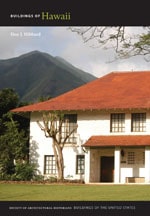
Originally surrounded by a plantation camp, the Waipahu Hongwanji now finds itself amidst the Jack Hall Elderly Housing complex, and a residential subdivision characterized by predominantly two-story houses using Filipino-inspired hollow-tile masonry construction, wrought-iron ornamentation, red tile roofs, and Baroque balustrades. The temple is a modern interpretation of Hawaii's Buddhist architectural traditions rendered in concrete. Melding Indian, Japanese, and Western forms with such climatic considerations as the nave's large triple-hung sash windows, the structure features such exquisite detailing as the portico's paired Tuscan columns united by a single abacus with an Ionic volute. The freestanding, square corner towers with glass-block vertical accents grant loftiness to the composition, and give it an Indian accent. However, the wraparound second-story lanai with its unique wrought-iron railing is reminiscent of Japanese engawa, and the portico's roofline has a faint karahafu form. On the interior, Japanese tradition is more strongly articulated by the brass chandelier and the naijin's side shōji and paneled ceiling. The naijin's stylized Indian cusped arches further enrich the mix.
This congregation was formed in 1901 to serve the plantation workers of the Oahu Sugar Company, which had erected its mill in Waipahu four years earlier. Plans to replace the original traditional Japanese temple with a similarly styled temple were in place by 1941; however, World War II led to the internment of the temple's minister and the postponement of its construction. After the war, the design of the proposed new building was revisited, and the more contemporary, ethnically ambiguous composition emerged.

